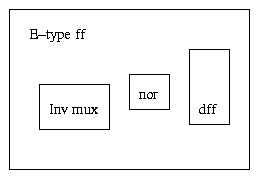
The E-type flip flop is made of a D-type flip flop, an inverting multiplexor and a nor gate. We see this hierarchy in the figure below. We can break the mutliplexor down further but this level of detail is sufficient for this section.

There are two angles to approach the design of the E-type flip flop in
Verilog:
Topdown-
start with the E-type flip flop and add more detail.
Bottom
up-
start with the basic flip flop an inverting multiplexor and a nor gate,
and build up, ie generalise the detail.
We will use a bottom up methodology, but typically a combination of both is used.
We start with the D-type, it is encapsulated as a module, enclosed in
the keywords
module
<module_name> ...
endmodule,
as below.
module dff(q, data, clock);
output q;
input data, clock;
reg q;
always @(posedge clock)
q = data;
endmodule // dff
module mux2_1(out, in1, in2, cntrl);
output out;
input in1, in2, cntrl;
assign out = cntrl ? ~in1 : ~in2;
endmodule // mux2_1
module e_ff(q, data, enable, reset, clock);
output q;
input data, enable, reset, clock;
wire norout, muxout;
mux2_1 mod1 (muxout, data, q, enable);
nor (norout, reset, muxout);
dff dff0 (q, norout, clock);
endmodule